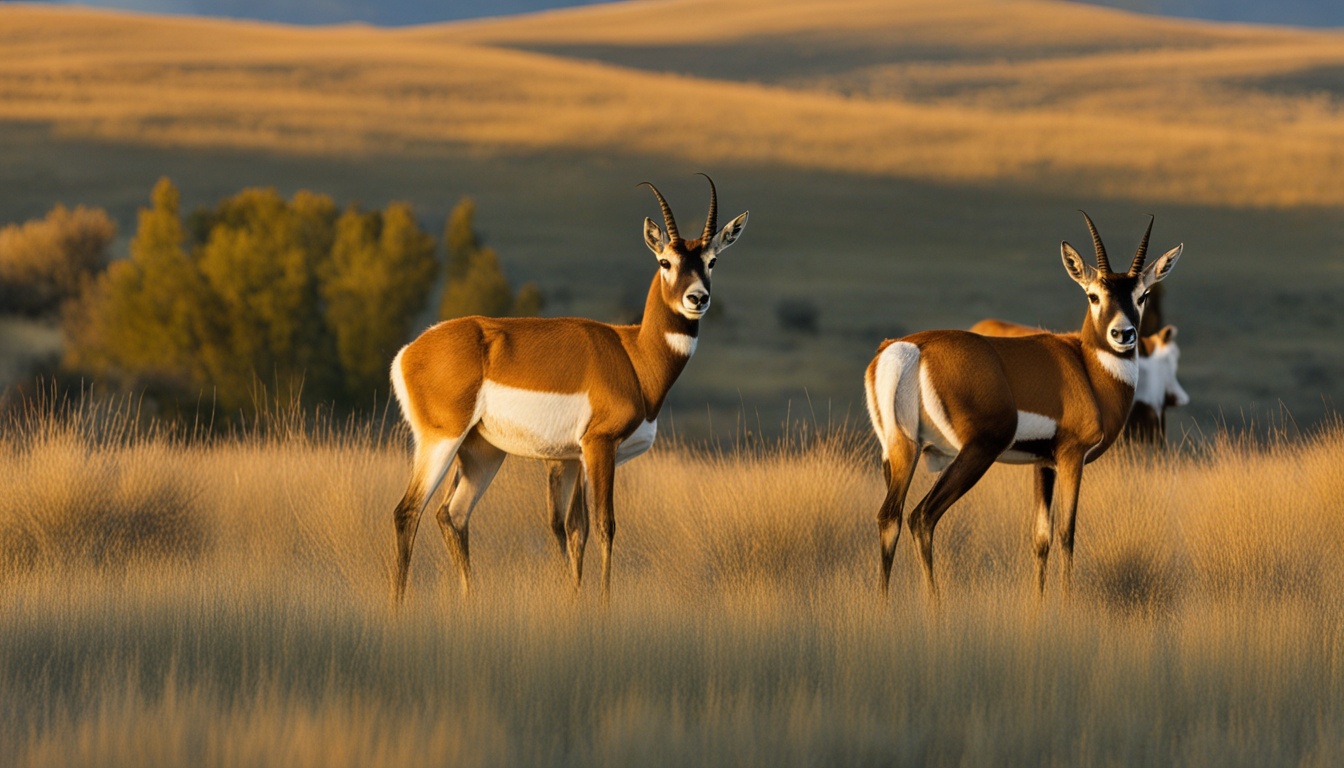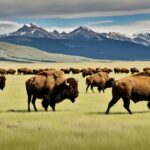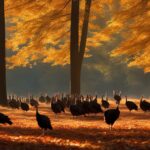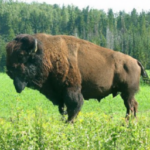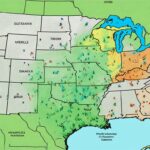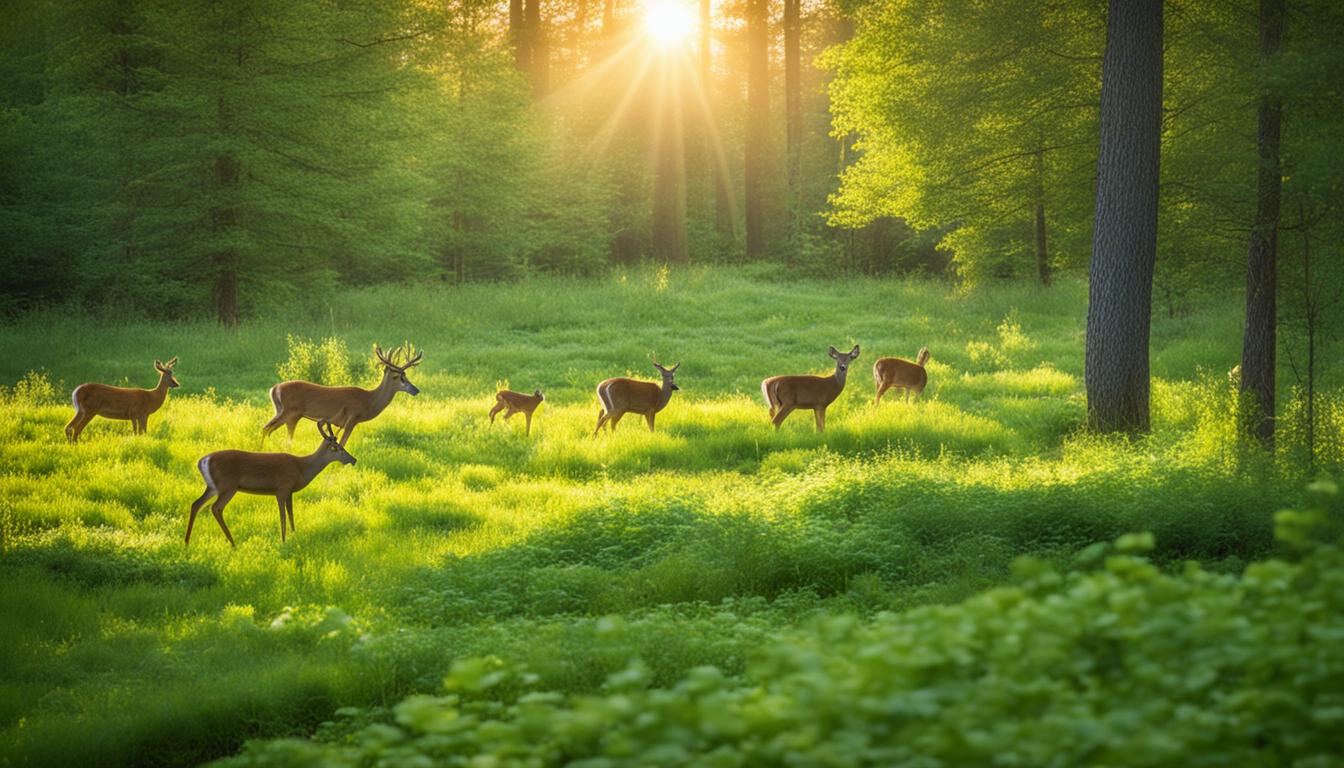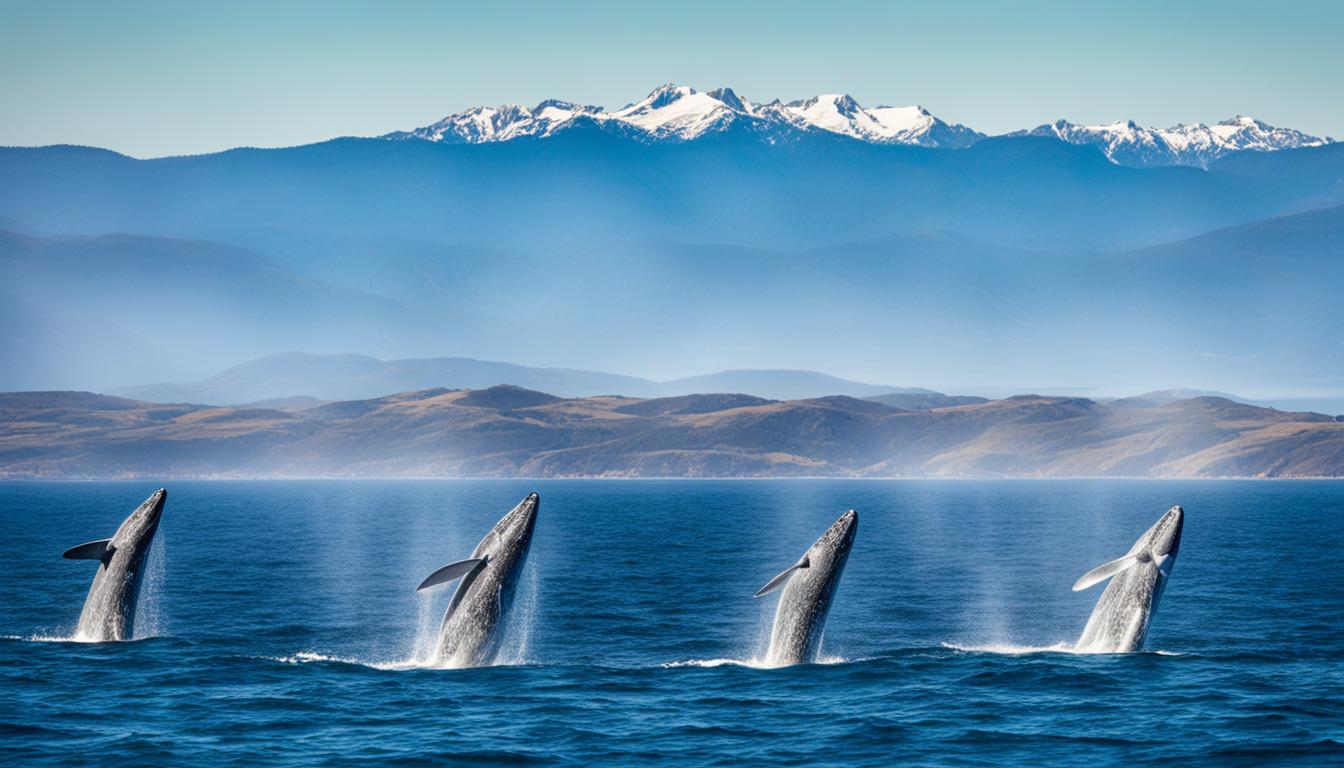Have you ever asked where to see the pronghorn antelope, one of North America’s fastest creatures?
They call the open lands west of the Mississippi River home. From southern Canada to central Mexico, these lands are their kingdom. Today, you can find them in many states, including Arizona, Colorado, and Oregon.
Known for their incredible speed, pronghorns have clever ways to escape danger. They run fast for a long time, which helps them survive without jumping much.
Sometimes, they might wander into fields, which can cause problems. Despite facing tough times in the past, they show amazing resilience. This makes pronghorns a big draw for nature lovers.
Introduction to Pronghorn Antelope
The pronghorn antelope, or Antilocapra americana, is a vital part of North American wildlife. They are very different because of their special horns and fast running ability. They play a big role in keeping the environment balanced. Despite not being true antelopes, they have done very well in different environments.
What is a Pronghorn Antelope?
There are many cool pronghorn antelope facts that make them stand out. Pronghorns have horns that fall off and grow back each year. They can run as fast as 55 mph, a skill that helped them survive. Their speed, long distance running, and sharp eyes make them top land animals in North America.
Historical Significance of Pronghorn Antelope in America
The pronghorn antelope population has an interesting story in America. They were seen by Spanish explorers and on the famous Lewis and Clark Expedition. At first, there were about 35 million of them. But then their numbers dropped a lot because of hunting and loss of land. Thanks to conservation efforts, their population has recovered. Now, they live in many places in the western U.S., showing the strength of American wildlife.
Pronghorn Antelope in Yellowstone National Park
Yellowstone National Park is a key home for pronghorn antelopes, with around 500-600 living there in 2022. These adaptable animals move around the park during the year. In summer, you can see them in Lamar Valley. In winter, they’re often seen near the North Entrance and Reese Creek.
The pronghorn antelope population in the park has faced many challenges, including hunting and problems with livestock. But since the mid-2000s, their numbers have started to grow again. This is because of focused recovery efforts.
Yet, pronghorns in Yellowstone are still seen as vulnerable. Harsh winters and disease can hurt their population greatly. Saving these animals is important for keeping the park’s environment healthy. Their story shows how good conservation efforts can make a difference.
Top States to Spot Pronghorn Antelope
If you’re excited to see pronghorn antelope, head to certain U.S. states. These places are perfect for spotting them because of their great living conditions. The states have the right environment and routes for pronghorn antelope to thrive.
Wyoming
Wyoming is a top choice due to its huge open areas. You’ll see pronghorn antelope in their natural state, moving across the land. Places like Jackson Hole and Grand Teton National Park are perfect for this.
Montana
In Montana, you’ll find a lot of pronghorn antelope. Try visiting Paradise Valley. You’ll see these amazing animals in the wide grasslands and during their travels.
Oregon
Oregon, while not as abundant as Wyoming and Montana, also hosts pronghorn antelope. Places like Fort Rock add to the state’s variety. Pronghorn antelope in Oregon move across open lands for fresh food, a great sight to see.
Where can you find pronghorn antelope in the USA?
The pronghorn antelope live in the interior western and central United States. They also venture into Canada and Mexico. Places like Wyoming, Montana, and Oregon have many of them. Efforts like removing fences and restoring their homes have helped them return to these areas.
Despite being under ‘Least Concern’ for now, pronghorns still need our care. There are dangers and their homes are breaking up. Efforts made for their conservation have been good. But, we must keep helping them to make sure they and their homes stay safe.
| State | Population | Conservation Status |
|---|---|---|
| Wyoming | 400,000 | Stable |
| Montana | 150,000 | Increasing |
| Oregon | 30,000 | Stable |
Pronghorn Antelope Populations and Diet
Pronghorn antelopes once had millions in their population. But, due to human actions like losing their habitat and hunting, their numbers dropped a lot. Thanks to conservation work, their population has gone up. This work includes fixing up their habitats, controlling hunting, and creating paths for them to move.
The pronghorn antelope diet changes to fit what’s available. They mainly eat sagebrush, forbs, and shrubs, with grass being their least liked food. During winter, they eat more shrubs since other foods might be hard to find. Moving to new areas helps them find better food more easily.
In winter, these antelope come together in groups that mix males and females. This helps them find food over larger areas and watch out for dangers together. It increases their chances of staying safe and well-fed.
| Season | Primary Diet Components |
|---|---|
| Spring | Forbs, Shrubs |
| Summer | Sagebrush, Forbs |
| Fall | Shrubs, Forbs |
| Winter | Shrubs |
Natural Habitat of Pronghorn Antelope
The pronghorn antelope loves places ranging from open grasslands to well-watered shrublands. They’re found mostly from 900 to 1,800 meters high. They need a lot of rains, about 250–400 millimeters each year, to live comfortably. Their homes are shaped by the weather and where they are on the map.
Grasslands and Shrublands
Grasslands are perfect for pronghorn antelope. They are wide open, making it easy to spot predators and run away. Shrublands, on the other hand, provide hiding spots and food. Areas with sagebrush and small shrubs draw pronghorns in.
The mix of being able to see around and find food in these areas makes it just right for the pronghorn antelope.
Adaptations to Different Climates
Pronghorn antelopes have amazing adaptations to live in all kinds of weather. Their bodies are made with a large windpipe and lungs for quick breathing when they run. They also run in groups to keep their young safe. These strategies help them thrive in every climate.
Thanks to these special traits, pronghorns can live in places from dry deserts to rich grasslands.
Pronghorn Antelope Migration Patterns
Pronghorn antelope migration is an amazing natural event. It allows these creatures to live well in many places. This migration is key for their survival. It also helps keep their genes diverse and lowers the risk of being hunted.
They move from place to place in search of food. This way, they always find what they need to eat.
When the weather changes, pronghorns start their long trips. They travel many miles to find better living conditions. Their journeys help keep the ecosystem in balance by moving important nutrients around.
Fences often block their way and slow down their journey. People are trying to keep their paths clear to help them. These open paths are important for pronghorns to move freely without any obstacles.
We learn a lot from studying how pronghorn antelopes migrate. This information is crucial for protecting and managing their populations. By making sure they can keep moving, we make their future more secure. We also get to enjoy seeing them in our lands for years to come.
| Key Aspects | Details |
|---|---|
| Migration Timing | Triggered by environmental cues |
| Forage Availability | Seasonal range adjustments |
| Genetic Diversity | Migration promotes genetic mixing |
| Challenges | Barriers such as fences |
| Conservation Efforts | Maintaining migratory corridors |
Threats to Pronghorn Antelope
Pronghorn antelopes face many threats from both people and nature. These threats include habitat loss and dangers from predators and human activities. These challenges make it hard for conservationists to protect the antelopes.
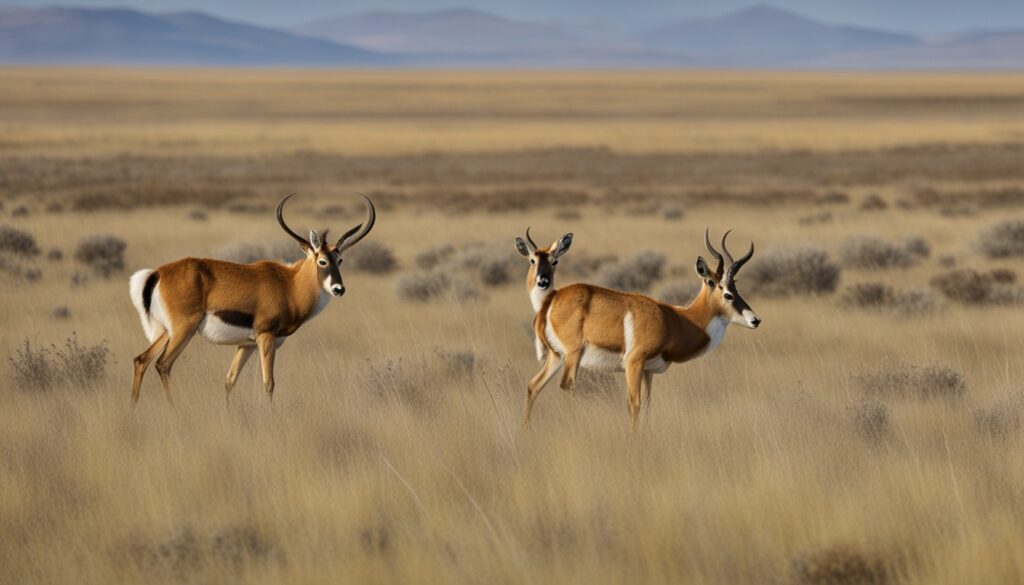
Human Activities
There are many ways humans impact pronghorn antelopes. These include breaking up their land with fences and building, causing accidents with cars, and fighting over farmland. Fences stop the antelopes from moving as they should, which is bad for their survival.
Building towns and roads around their areas makes it harder for them to get food and water. They often get hit by cars, which can be deadly when they’re moving. This is a big problem during their yearly travels.
Natural Predators
In the wild, pronghorn antelopes face dangers from predators. Coyotes, bobcats, wolves, bears, and eagles hunt the young ones. This adds to the antelopes’ struggles, alongside the problems caused by humans. Efforts to manage predators and help the antelopes’ habitats are critical.
Sickness, like the blue-tongue virus, also kills a lot of them. So, keeping up with their health and catching outbreaks fast is very important. All these challenges make protecting the pronghorn antelopes a complex but vital task for nature conservation.
Conservation Efforts for Pronghorn Antelope
Efforts to save the pronghorn antelope have boosted their numbers in many places. They use a mix of strategies to deal with different problems. This helps the pronghorn antelope find the right living spaces to grow.
Preserving water sources is key as well. By protecting water, experts make sure pronghorns can always find what they need to live. They also manage hunting carefully to keep nature in balance and the antelopes healthy for a long time.
Using fences that don’t block the antelopes’ paths is a smart move. These new fences make it easy for the antelopes to keep moving freely. That way, their natural way of moving around is not stopped.
Many groups, including wildlife experts and local people, work together to save the pronghorn antelope. Thanks to these efforts, these animals can now be seen in areas where they used to live long ago. This has helped bring back more kinds of animals and plants, making nature healthier for everyone.
Best Times of the Year to See Pronghorn Antelope
Knowing the best time to see pronghorn antelope is key for a great wildlife trip. These animals show up at different times, depending on where they live and their habits.
Spring and Summer
Spring and summer are great for pronghorn antelope sightings. In these seasons, they’re in open areas, eating and caring for their young. The good weather and fresh food draw them out and make it easier to find them.
Fall and Winter
Fall is their mating time. You can see exciting things like males protecting their areas and groups of females. By winter, they move to places with less snow. This means you might spot larger groups of them in different parts than in summer.
Knowing about their changing behaviors can help you plan a trip for the best sightings. It ensures your adventure with pronghorn antelope will be unforgettable.
| Season | Visibility | Behavior | Location |
|---|---|---|---|
| Spring | High | Foraging, raising young | Open grasslands |
| Summer | High | Foraging, raising young | Open grasslands |
| Fall | Medium | Mating season, territorial defense | Various |
| Winter | Medium | Migration, herd formation | Low-snow regions |
Ecological Importance of Pronghorn Antelope
The pronghorn antelope is more important than we might think. It’s a key species for grasslands. Its actions have a big impact, even on things we might not see. Knowing about this helps us protect nature and its variety of life.
Role in the Food Chain
Pronghorn antelopes are crucial in the food chain. They are a main meal for animals like coyotes and golden eagles. This eating helps keep different animal populations in check, keeping nature’s balance. Their quickness and sharp senses also shape how their predators evolve, making nature an exciting place.
Impact on Grassland Ecosystems
Pronghorn antelopes change grasslands by what they eat. They pick certain plants, helping those and other plants grow. This mix of green spaces supports many animals, making nature more diverse. Plus, their seasonal travels help keep these lands healthy and strong, covering wide areas.
Additional Facts about Pronghorn Antelope
Pronghorn antelopes are amazing animals in North America. They have a cool trick – they can eat toxic plants others can’t. This lets them live in places where food is scarce or others are competing for it.
What’s really special is their wide vision. They can see almost all around them. This helps them spot danger far away, making them more likely to survive. It’s a big help in all the different places they live.
But, their speed is their standout feature. Pronghorns are not as fast as cheetahs for short races. But, they can run fast for a long time. This helps them escape threats and move efficiently over their home area. Knowing these facts shows how amazing pronghorn antelopes are. And it’s a reminder of why we need to protect them for the future.

